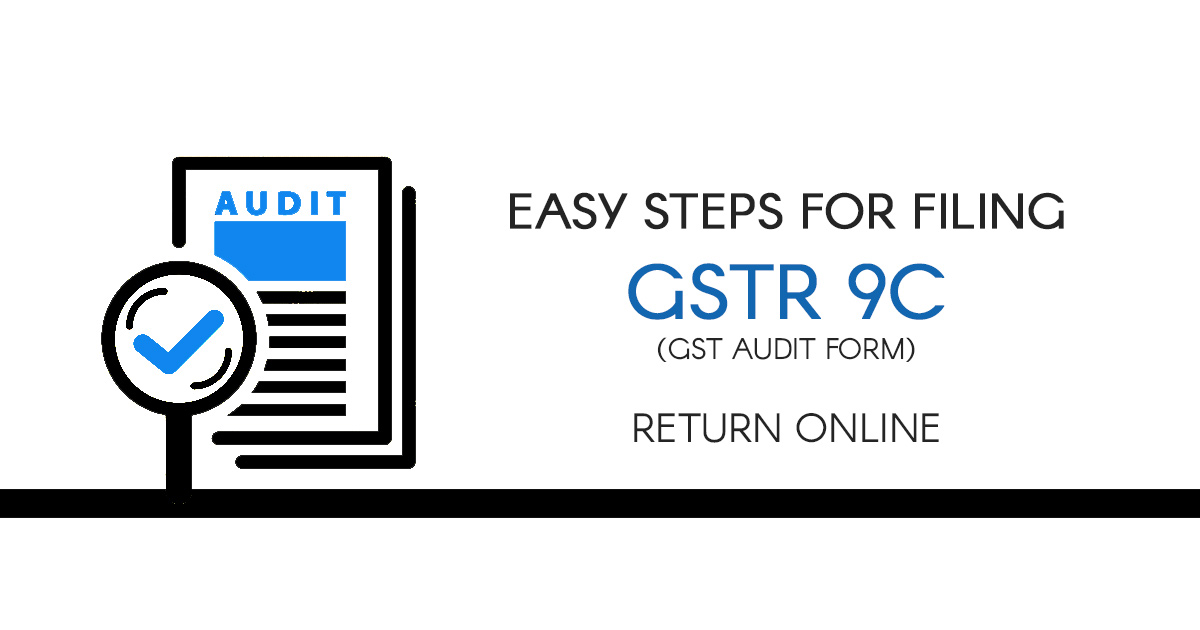GSTR 9C is defined as an annual GST audit form for the taxpayers who have the turnover above 2 crores in a specific financial year. The taxpayer must fill the reconciliation statement with the certification of an audit, along with the GSTR 9C audit form. The GSTR 9C format was introduced by the authorities on September 13, 2018, which states the Notification No. 49/ 2018- Central tax.
GST Helpline is here to give all the applicable points of GSTR 9C and well-ordered strategy to record them alongside the screen capture. The GSTR 9C form has the compromise explanation for accommodating turnover, input tax credits and tax payments.
Contents
What is GSTR 9C Annual Audit Form?
As per the rule of GSTR 9, all the taxpayer will have to file an annual return form, but now as per the current rule, Section 35 of CGST ACt, 2017, the taxpayers who have the turnover above 2 crores in a specific financial year must submit audited annual accounts alongside a reconciliation statement in GSTR 9C form.
Download GSTR 9C in PDF format
Who can file the GSTR 9C (GST Audit Form)?
Taxpayers who have the turnover above 2 crores in a specific financial year are required to file GSTR 9C form alongside a reconciliation statement and certification of an audit.
What is the due date for filing GSTR 9C Audit Form?
For eligible taxpayers of India, the filing GSTR 9C Due Date is 31st January 2020 for FY 2017-18.
- Revised GSTR-9C due date for FY 2017-18 – 31st January 2020* (Check Notification)
- GSTR-9C due date for FY 2018-19 – 31st March 2020*
Also Read: How to file GSTR 9A annual return?
Step by Step Process to File GSTR 9C Return Online
The GSTR-9 is partitioned into five parts and 16 tables:
Part 1: Given below are the basic details of four sections: Financial Year for which return is filed.
- 1. Financial Year
- 2. GSTIN of the taxpayers
- 3A. Legal Name of the registering person (automatic)
- 3B. Trade Name (if any) of the registering business (automatic)
- 4. Whether the taxpayer is liable for any audit under this act
Note: For FY 2017-18, it will contain details for July 2017 to March 2018 period.

Part 2: Reconciliation of turnover declared in the audited Annual Financial Statement with turnover declared in Annual Return (GSTR 9)
- 5. Reconciliation of Gross Turnover
- 5A. Turnover (including exports) as per audited financial statements for the State / UT (For multi-GSTIN units under same PAN the turnover shall be derived from the audited Annual Financial Statement): The turnover as per the audited Annual Financial Statement shall be declared here. There may be cases where multiple GSTINs (State-wise) registrations exist on the same PAN. This is common for persons/entities with a presence over multiple States. Such persons/entities will have to internally derive their GSTIN wise turnover and declare the same here. This shall include export turnover (if any). It may be noted that reference to audited Annual Financial Statement includes reference to books of accounts in case of persons/entities having a presence over multiple States.
- 5B. Unbilled revenue at the beginning of Financial Year (+): Unbilled revenue which was recorded in the books of accounts on the basis of accrual system of accounting in the last financial year and was carried forward to the current financial year shall be declared here. In other words, when GST is payable during the financial year on such revenue (which was recognized earlier), the value of such revenue shall be declared here.
- C. Unadjusted advances at the end of the Financial Year (+): Value of all advances for which GST has been paid but the same has not been recognized as revenue in the audited Annual Financial Statement shall be declared here.
- D. Deemed Supply under Schedule I (+): an Aggregate value of deemed supplies under Schedule I of the CGST Act, 2017 shall be declared here. Any deemed supply which is already part of the turnover in the audited Annual Financial Statement is not required to be included here.
- E. Credit Notes issued after the end of the financial year but reflected in the annual return (+): an Aggregate value of credit notes which were issued after 31st of March for any supply accounted in the current financial year but such credit notes were reflected in the annual return (GSTR-9) shall be declared here.
- F. Trade Discounts accounted for in the audited Annual (+) Financial Statement but are not permissible under GST: Trade discounts which are accounted for in the audited Annual Financial Statement but on which GST was leviable(being not permissible) shall be declared here.
- G. Turnover from April 2017 to June 2017 (-): Turnover included in the audited Annual Financial Statement for April 2017 to June 2017 shall be declared here
- H. Unbilled revenue at the end of Financial Year (-): Unbilled revenue which was recorded in the books of accounts on the basis of accrual system of accounting during the current financial year but GST was not payable on such revenue in the same financial year shall be declared here.
- I. Unadjusted Advances at the beginning of the Financial Year (-): Value of all advances for which GST has not been paid but the same has been recognized as revenue in the audited Annual Financial Statement shall be declared here.
- J. Credit notes accounted for in the audited Annual Financial Statement but is not permissible under GST (-): an Aggregate value of credit notes which have been accounted for in the audited Annual Financial Statement but were not admissible under Section 34 of the CGST Act shall be declared here
- K. Adjustments on account of supply of goods by SEZ units to DTA Units (-): an Aggregate value of all goods supplied by SEZs to DTA units for which the DTA units have filed the bill of entry shall be declared here.Easy Guide to GSTR 9C GST Audit Form with Online Return Filing Process
- L. Turnover for the period under composition scheme (-): There may be cases where registered persons might have opted out of the composition scheme during the current financial year. Their turnover as per the audited Annual Financial Statement would include turnover both as for composition taxpayer as well as the normal taxpayer. Therefore, the turnover for which GST was paid under the composition scheme shall be declared here.
- M. Adjustments in a turnover under section 15 and rules thereunder (+/- ): There may be cases where the taxable value and the invoice value differ due to valuation principles under section 15 of the CGST Act, 2017 and rules thereunder. Therefore, any difference between the turnover reported in the Annual Return (GSTR 9) and turnover reported in the audited Annual Financial Statement due to the difference in valuation of supplies shall be declared here.
- N. Adjustments in turnover due to foreign exchange fluctuations (+/- ): Any difference between the turnover reported in the Annual Return (GSTR 9) and turnover reported in the audited Annual Financial Statement due to foreign exchange fluctuations shall be declared here
- O. Adjustments in turnover due to reasons not listed above (+/-): Any difference between the turnover reported in the Annual Return (GSTR 9) and turnover reported in the audited Annual Financial Statement due to reasons not listed above shall be declared here.
- P. Annual turnover after adjustments as above
- Q. Turnover as declared in Annual Return (GSTR 9): Annual turnover as declared in the Annual Return (GSTR 9) shall be declared here. This turnover may be derived from Sr. No. 5N, 10 and 11 of Annual Return (GSTR 9)
- R. Un-Reconciled turnover (Q – P) AT1

- 6. Reasons for Unreconciled difference in Annual Gross Turnover
Reasons for non-reconciliation between the annual turnover declared in the audited Annual Financial Statement and turnover as declared in the Annual Return (GSTR 9) shall be specified here.

- 7. Reconciliation of Taxable Turnover
The table provides for the reconciliation of taxable turnover from the audited annual turnover after adjustments with the taxable turnover declared in annual return (GSTR-9).
- A. Annual turnover after adjustments (from 5P above): Annual turnover as derived in Table 5P above would be auto-populated here.
- B. Value of Exempted, Nil Rated, Non-GST supplies, No-Supply turnover: Value of exempted, nil rated, non-GST and no-supply turnover shall be declared here. This shall be reported net of credit notes, debit notes and amendments if any.
- C. Zero-rated supplies without payment of tax: Value of zero-rated supplies (including supplies to SEZs) on which tax is not paid shall be declared here. This shall be reported net of credit notes, debit notes and amendments if any.
- D. Supplies on which tax is to be paid by the recipient on reverse charge basis: Value of reverse charge supplies on which tax is to be paid by the recipient shall be declared here. This shall be reported net of credit notes, debit notes and amendments if any
- E. Taxable turnover as per adjustments above (A-B-C-D): The taxable turnover is derived as the difference between the annual turnover after adjustments declared in Table 7A above and the sum of all supplies (exempted, non-GST, reverse charge etc.) declared in Table 7B, 7C and 7D above.
- F. Taxable turnover as per liability declared in Annual Return (GSTR 9): Taxable turnover as declared in Table 4N of the Annual Return (GSTR 9) shall be declared here.
- G. Unreconciled taxable turnover (F-E)

- 8. Reasons for Unreconciled difference in taxable turnover
- Reasons for non-reconciliation between adjusted annual taxable turnover as derived from Table 7E above and the taxable turnover declared in Table 7F shall be specified here.

Part 3: Reconciliation of tax paid
9. Reconciliation of rate wise liability and amount payable thereon
The table provides for the reconciliation of tax paid as per reconciliation statement and amount of tax paid as declared in Annual Return (GSTR 9). Under the head labeled ―RC‖, supplies where the tax was paid on reverse charge basis by the recipient (i.e. the person for whom reconciliation statement has been prepared ) shall be declared.
P. Total amount to be paid as per tables above: The total amount to be paid as per liability declared in Table 9A to 9O is auto-populated here
Q. Total amount paid as declared in Annual Return (GSTR 9): The amount payable as declared in Table 9 of the Annual Return (GSTR 9) shall be declared here. It should also contain any differential tax paid on Table 10 or 11 of the Annual Return (GSTR 9)

10. Reasons for un-reconciled payment of amount: Reasons for non-reconciliation between payable / liability declared in Table 9P above and the amount payable in Table 9Q shall be specified here.

11. Additional amount payable but not paid (due to reasons specified under Tables 6,8 and 10 above): Any amount which is payable due to reasons specified under Table 6, 8 and 10 above shall be declared here.

Part 4: Reconciliation of ITC
12. Reconciliation of Net ITC (Input Tax Credit)
A. ITC availed as per audited Annual Financial Statement for the State/ UT (For multi-GSTIN units under same PAN this should be derived from books of accounts): ITC availed (after reversals) as per the audited Annual Financial Statement shall be declared here. There may be cases where multiple GSTINs (Statewise) registrations exist on the same PAN. This is common for persons/entities with a presence over multiple States. Such persons/entities will have to internally derive their ITC for each individual GSTIN and declare the same here. It may be noted that reference to audited Annual Financial Statement includes reference to books of accounts in case of persons/entities having the presence over multiple States.
B. ITC booked in earlier Financial Years claimed in current Financial Year (+): Any ITC which was booked in the audited Annual Financial Statement of an earlier financial year(s)but availed in the ITC ledger in the financial year for which the reconciliation statement is being filed for shall be declared here. This shall include transitional credit which was booked in earlier years but availed during Financial Year 2017-18.
C. ITC booked in current Financial Year to be claimed in subsequent Financial Years (-): Any ITC which has been booked in the audited Annual Financial Statement of the current financial year but the same has not been credited to the ITC ledger for the said financial year shall be declared here.
D. ITC availed as per audited financial statements or books of account: ITC availed as per audited Annual Financial Statement or books of accounts as derived from values declared in Table 12A, 12B and 12C above will be auto-populated here.
E. ITC claimed in Annual Return (GSTR 9): Net ITC available for utilization as declared in Table 7J of Annual Return (GSTR 9) shall be declared here.

13. Reasons for unreconciled difference in ITC
Reasons for non-reconciliation of ITC as per audited Annual Financial Statement or books of account (Table 12D) and the net ITC (Table12E) availed in the Annual Return (GSTR 9) shall be specified here.

14. Reconciliation of ITC declared in Annual Return (GSTR 9) with ITC availed on expenses as per audited Annual Financial Statement or books of account.
This table is for the reconciliation of ITC declared in the Annual Return (GSTR 9) against the expenses booked in the audited Annual Financial Statement or books of account. The various sub-heads specified under this table are general expenses in the audited Annual Financial Statement or books of account on which ITC may or may not be available. Further, this is only an indicative list of heads under which expenses are generally booked. Taxpayers may add or delete any of these heads but all heads of expenses on which GST has been paid/was payable are to be declared here.
A. Purchases
B. Freight / Carriage
C. Power and Fuel
D. Imported goods (Including received from SEZs)
E. Rent and Insurance of Goods lost, stolen, destroyed, written off or disposed of by way of gift or free samples
G. Royalties
H. Employees’ Cost (Salaries, wages, Bonus etc.)
I. Conveyance charges
J. Bank Charges
K. Entertainment charges
L. Stationery Expenses (including postage etc.)
M. Repair and Maintenance
N. Other Miscellaneous expenses
O. Capital goods
P. Any other expense 1
Q. Any other expense 2
R. Total amount of eligible ITC availed: Total ITC declared in Table 14A to 14Q above shall be auto-populated here.
S. ITC claimed in Annual Return (GSTR-9): Net ITC availed as declared in the Annual Return (GSTR 9) shall be declared here. Table 7J of the Annual Return (GSTR 9) may be used for filing this Table.
T. Un-reconciled ITC | ITC 2

15. Reasons for the un-reconciled the difference in ITC: Reasons for non-reconciliation between ITC availed on the various expenses declared in Table 14R and ITC declared in Table 14S shall be specified here.

16. Tax payable on the unreconciled difference in ITC (due to reasons specified in 13 and 15 above): Any amount which is payable due to reasons specified in Table 13 and 15 above shall be declared here.

Part 5: Auditor’s recommendation on additional Liability due to non-reconciliation
- Part V consists of the auditor’s recommendation on the additional liability to be discharged by the taxpayer due to non-reconciliation of turnover or non-reconciliation of input tax credit. The auditor shall also recommend if there is any other amount to be paid for supplies not included in the Annual Return. Any refund which has been erroneously taken and shall be paid back to the Government shall also be declared in this table. Lastly, any other outstanding demands which are recommended to be settled by the auditor shall be declared in this Table.








